________________
Jennifer Marman and Daniel Borins Google (2010)
‘Google implicates viewers and passers-by, whether they agree to participate or not. Reflecting the manner in which the search engine company of the same name watches users and records their behaviours for unclear purposes, these giant, child-like “googley” eyes use hidden electronic technology to watch people as they pass through the gallery space. The use of this kind of constant surveillance, in both the physical world and the virtual world of the Internet is on the rise. Security cameras are now pervasive in all cities where they watch practically every corner.’
________________
Zach Blas Facial Weaponization Communiqué: Fag Face (2012)
‘Facial Weaponization Suite protests against biometric facial recognition–and the inequalities these technologies propagate–by making “collective masks” in workshops that are modeled from the aggregated facial data of participants, resulting in amorphous masks that cannot be detected as human faces by biometric facial recognition technologies. The masks are used for public interventions and performances. One mask, the Fag Face Mask, generated from the biometric facial data of many queer men’s faces, is a response to scientific studies that link determining sexual orientation through rapid facial recognition techniques. Another mask explores a tripartite conception of blackness: the inability of biometric technologies to detect dark skin as racist, the favoring of black in militant aesthetics, and black as that which informatically obfuscates. A third mask engages feminism’s relations to concealment and imperceptibility, taking veil legislation in France as a troubling site that oppressively forces visibility. A fourth mask considers biometrics’ deployment as a security technology at the Mexico-US border and the nationalist violence it instigates. These masks intersect with social movements’ use of masking as an opaque tool of collective transformation that refuses dominant forms of political representation.’
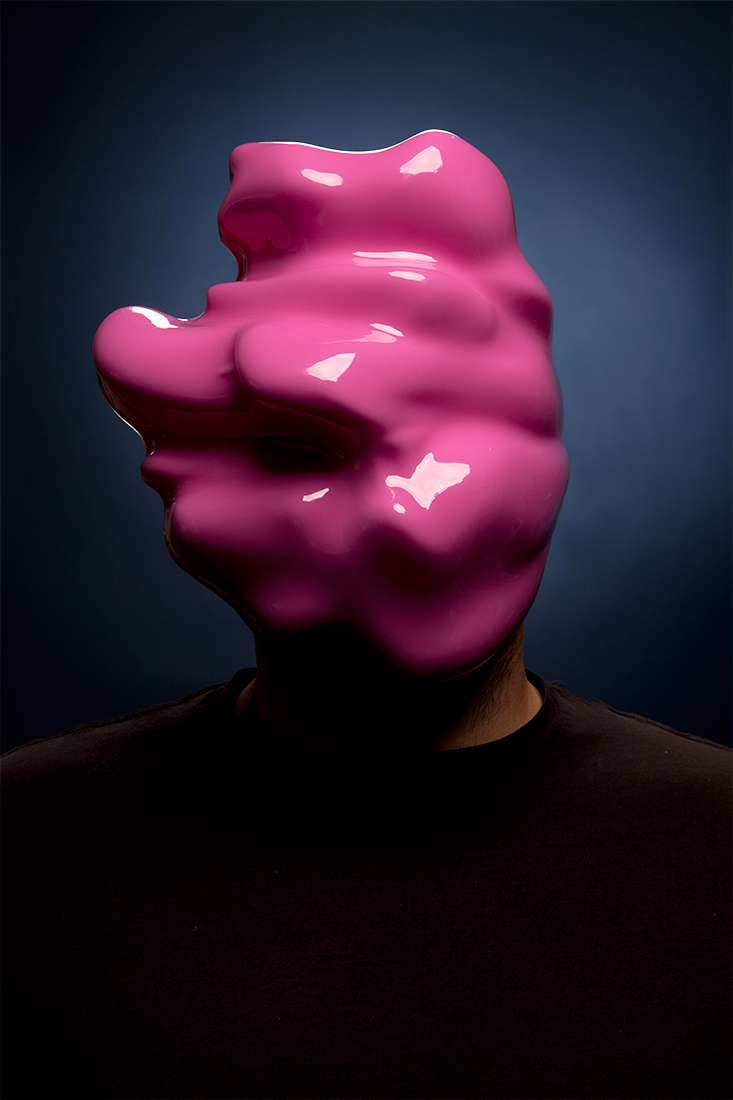
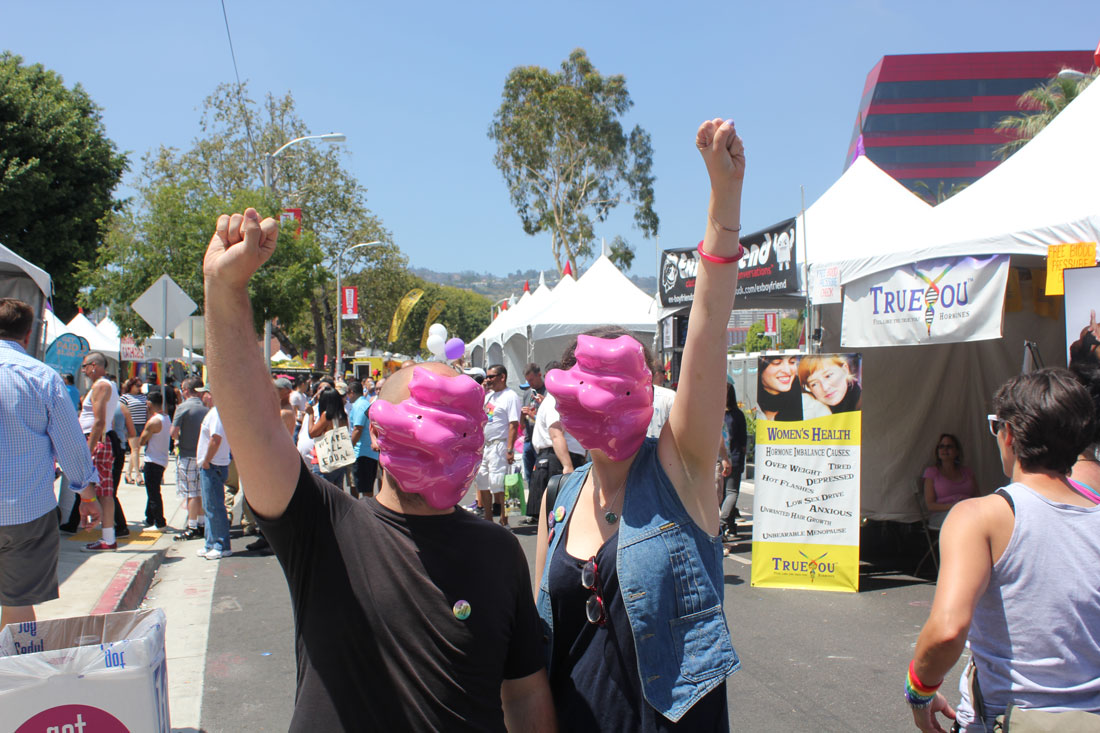
________________
Antonia Hirsch The Invisible Hand (after Adam Smith) (2009)
‘The phrase appears in Adam Smith’s book The Wealth of Nations, where the economist speaks of the “invisible hand of the market.” He proposes that an individual’s self-interested actions will inevitably also benefit the community, and implies that markets, if left alone, will self-regulate. Smith suggests that the ideal market is blind in the same way that justice should be blind or unbiased. Convex mirrors are intended to function as a kind of all-seeing eye. They can often be encountered in retail contexts where they serve the purpose of theft prevention.’
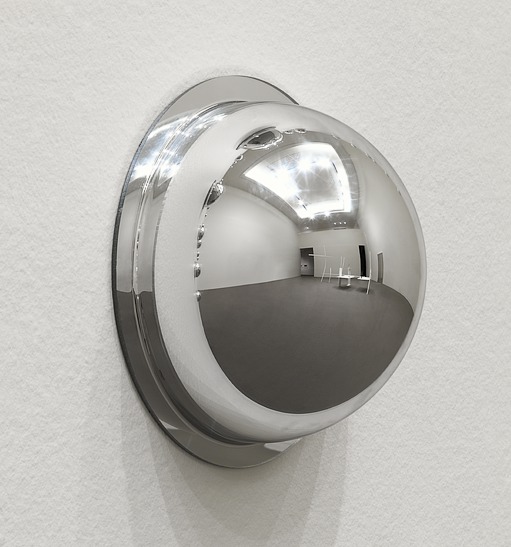
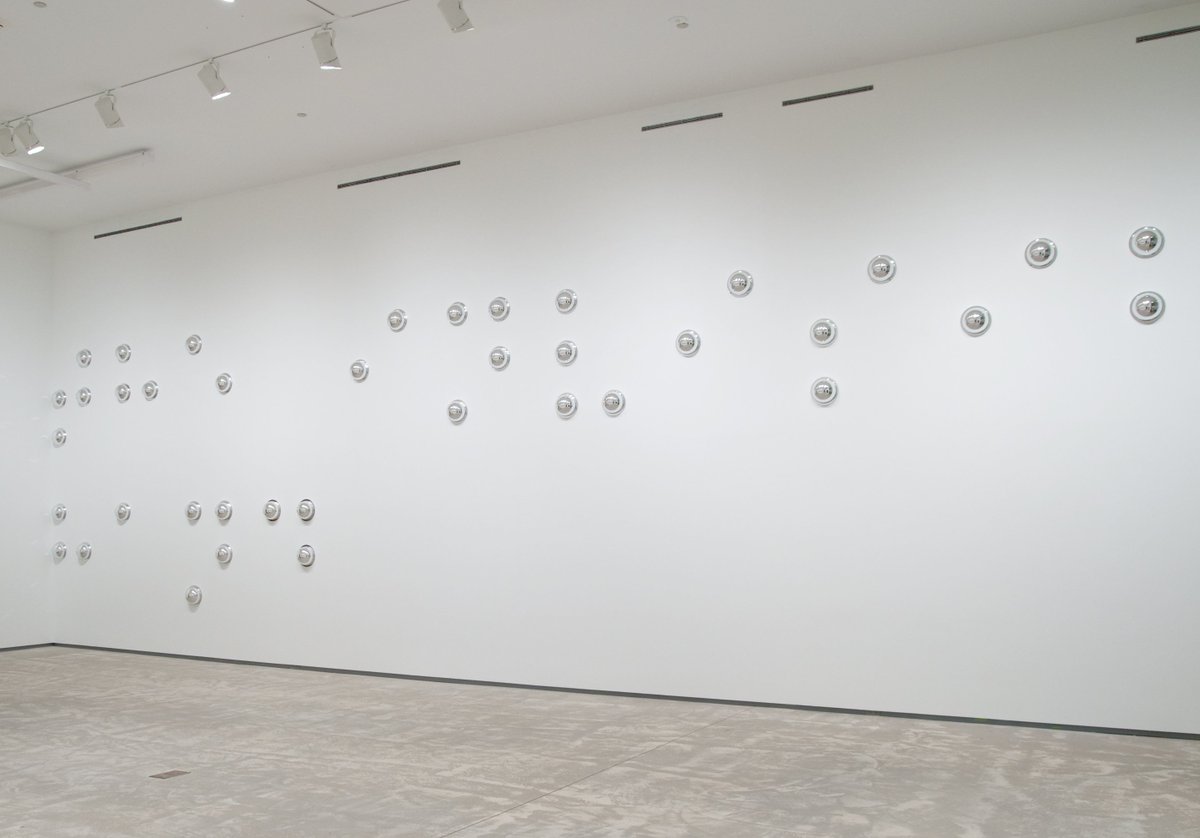
________________
Stéphane Degoutin, Gwenola Wagon and Pierre Cassou-Noguès Welcome to Erewhon (2018-2019)
‘Back from the dead, the visionary English writer Samuel Butler comments, behind the screens, on images found on the Internet. Erewhon is an adaptation of Samuel Butler’s visionary novel, Erewhon, published in 1872. He described his discovery of a strange country, where machines were banned. One hundred and fifty years later, Erewhon has changed a lot. Automation has been pushed to its extreme limits. The work as we know it has disappeared. The inhabitants are relieved of their burdensome duties and engage in recreational activities. Humans are now only working to expand their leisure activities. The infantile period extends well beyond its usual limits. Seal robots take care of the elderly and purr according to artificial intelligence software. Cats map the territory. Vacuum cleaners awaken to sensuality. The brains of humans, animals and plants are equally connected in a system of interconnected data centres that process all mental matter.’
_______________
Germain Koh and Ian Verchere Broken Arrow (2009)
‘Broken Arrow uses sensing hardwares to track and trace blue-tooth technologies within a particular radius of the piece. The artwork captures the signals and electronic communication found in wireless devices such as Bluetooth, Wi-Fi, cellular phones, radio, and GPS, each registered signal marked by an auditory signal and a visual design. In this way, Broken Arrow makes visible these often invisible technologies and their signals. Koh’s installation reveals the often unseen ways information transmitted and shared via social devices, and reminds its viewers about the risks associated with social networks and privacy.’
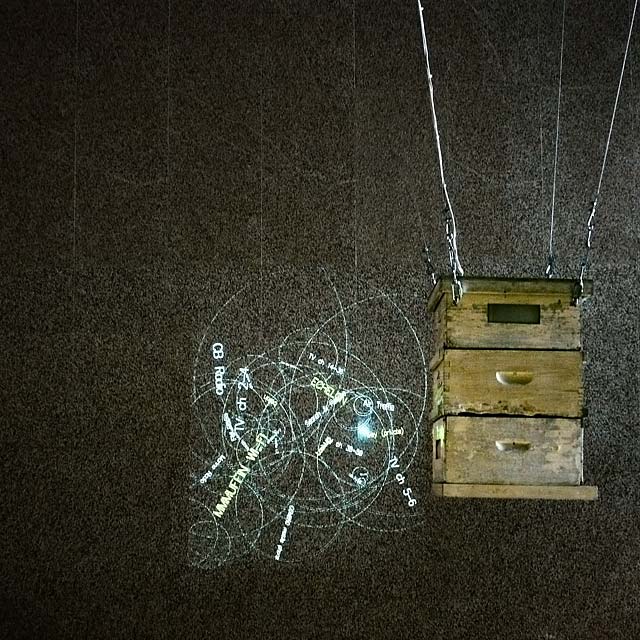
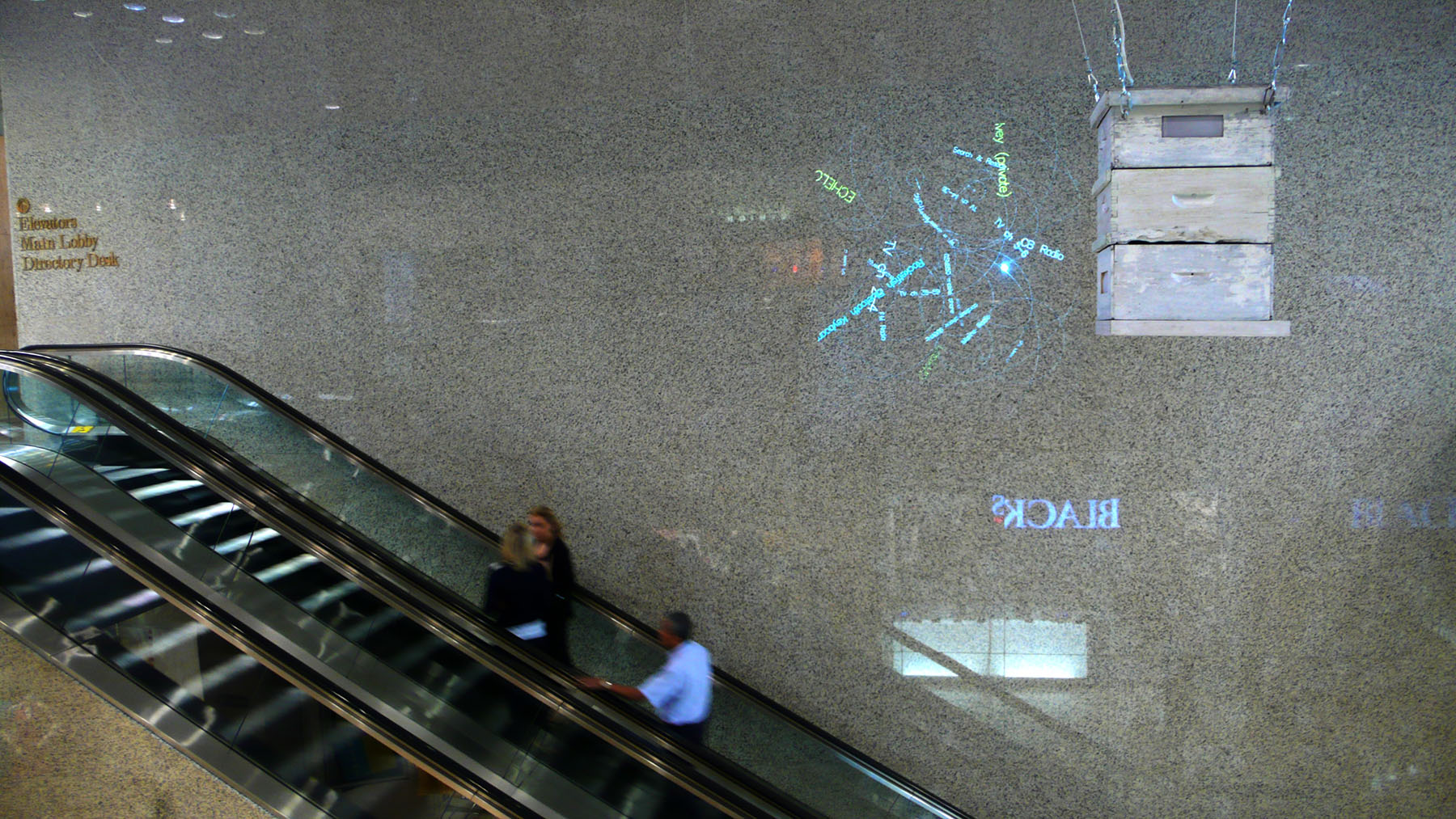
________________
Jakub Geltner Nest # 6 (2015)
‘As visitors meander along the winding path leading to Sydney’s magnificent Bodni beach, an unusual sort of street pole greets them upon arrival. Attached to a modified beam is a dense cluster of CCTV cameras, each pointing their spying lens at passing pedestrians below.’
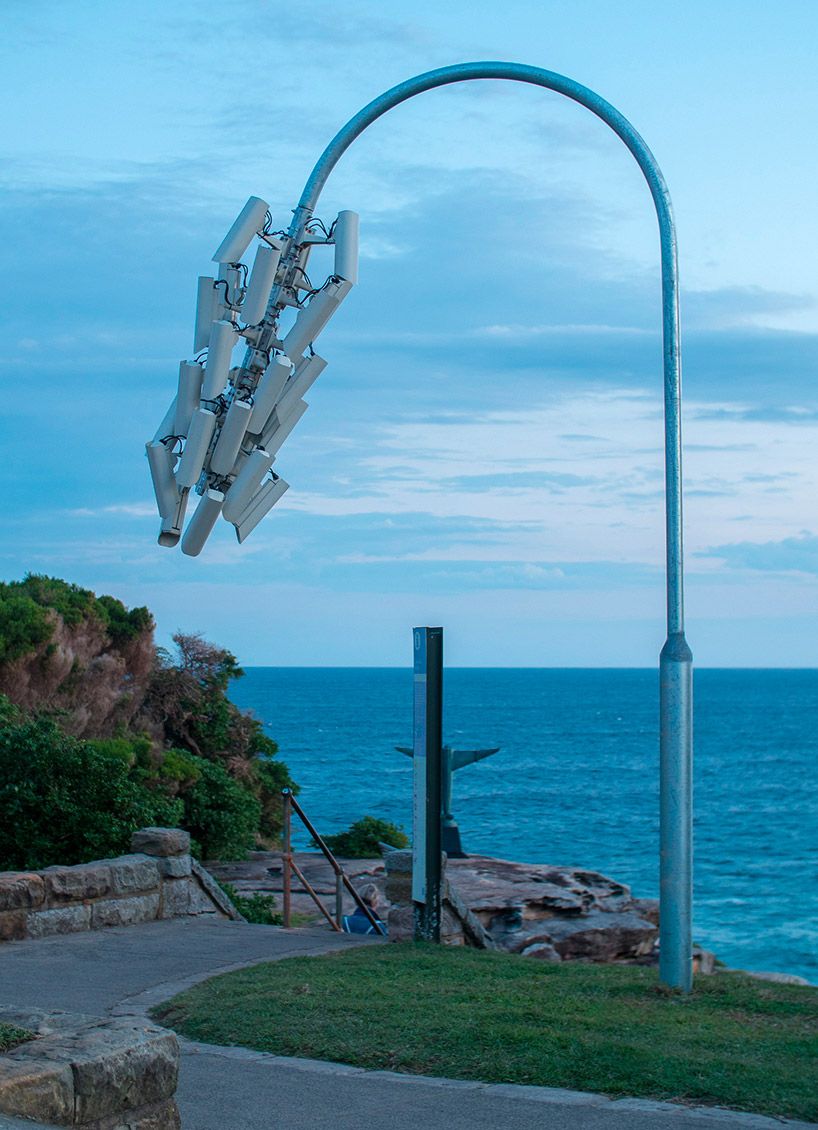
________________
Greg Barth Islam 21 (2018)
‘Exploring the concept of Islam in 21st century Europe, this sculpture is about the unprecedented state surveillance, paranoia and finger pointing that is surrounding this beautiful and peaceful religion.’

________________
Jill Magid Trust (2004)
‘In 2004, Jill spent 31 days in Liverpool, during which time she developed a close relationship with Citywatch (Merseyside Police and Liverpool City Council), whose function is citywide video surveillance- the largest system of its kind in England. The videos in her Evidence Locker were staged and edited by the artist and filmed by the police using the public surveillance cameras in the city centre. Wearing a bright red trench coat she would call the police on duty with details of where she was and ask them to film her in particular poses, places or even guide her through the city with her eyes closed, as seen in the video Trust.’

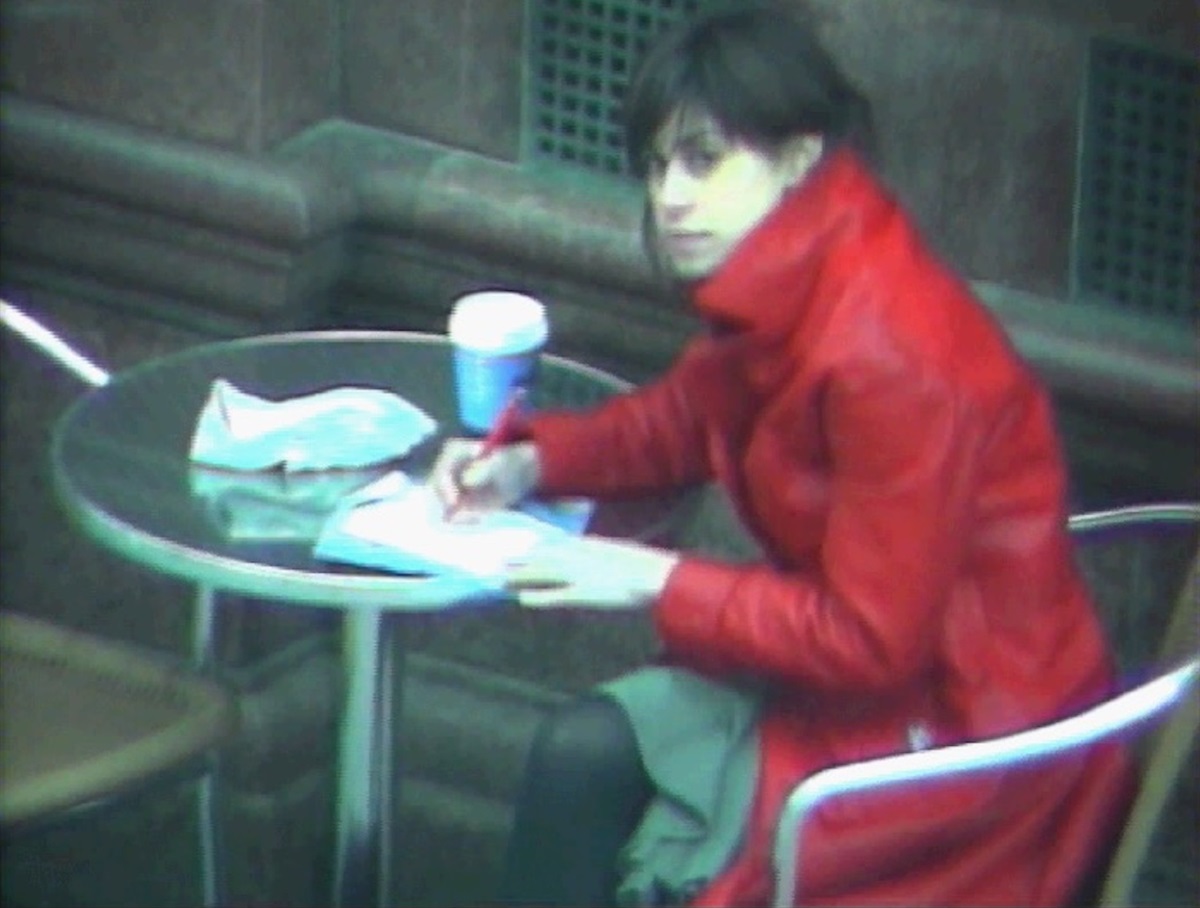
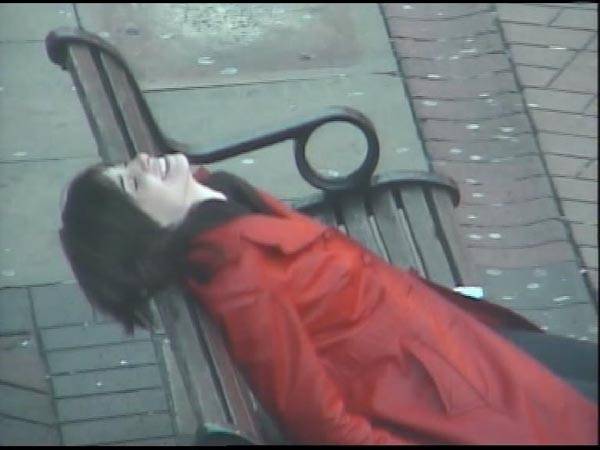
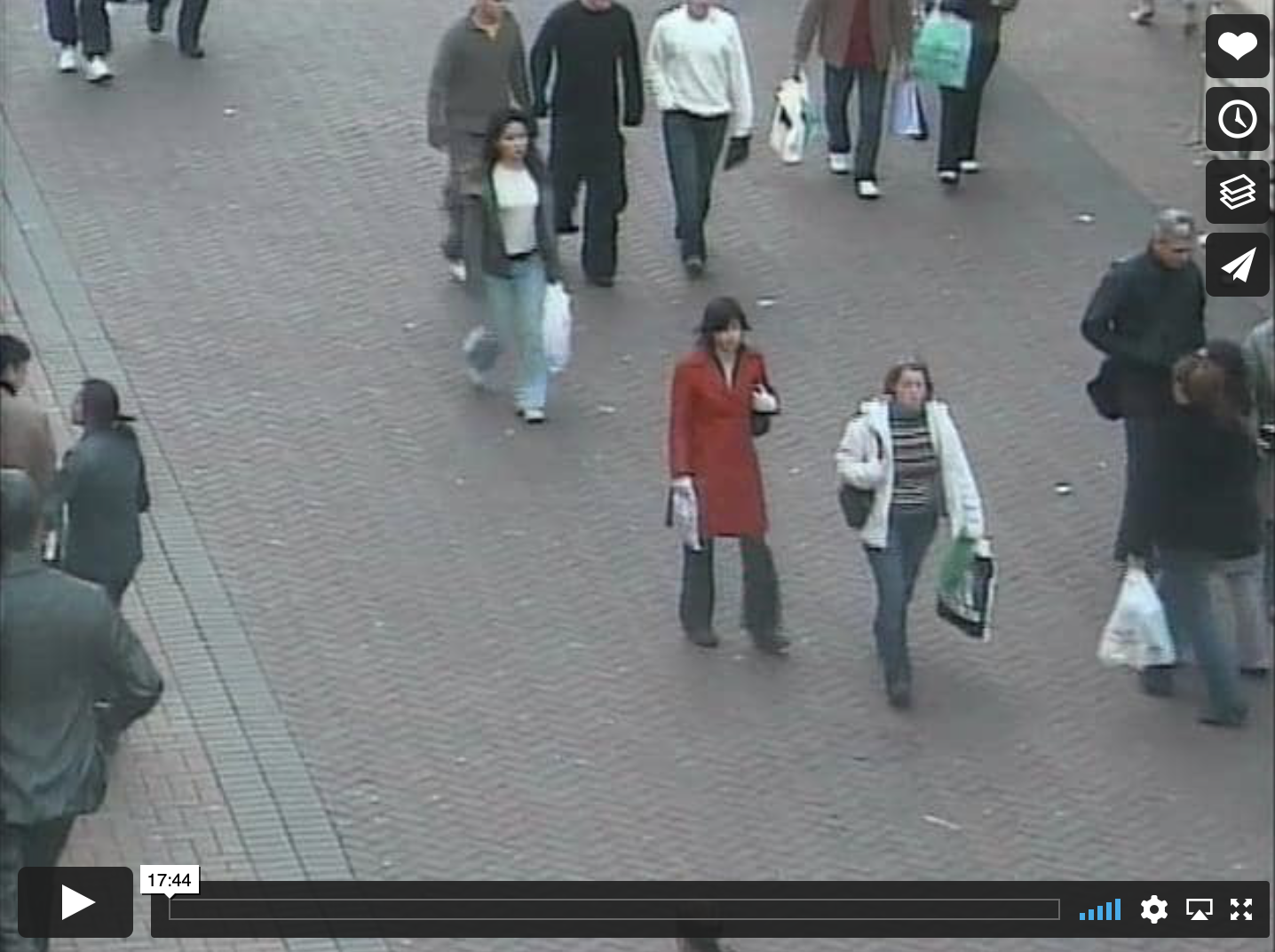
________________
David Rokeby Gathering (2004-6)
‘”Gathering” is a large immersive video installation that gathers moving images of people from outside the building. It separates these images into moving fragments of coherent colour which are then arranged and sorted according to a shifting set of rules across 8 video screens. First, moving people are located by a camera that can pan around the area. They are separated from the background, and then analyzed for colour content. Flesh toned areas are separated from clothing and the clothing is divided into areas of like colour. These moving patches of colour (heads, t-shirts, jeans, coats, hands) are then sorted across the screens. The patches are organized by 3 different sets of rules at different times. In one set of rules, they are sorted by hue along the horizontal and by saturation (colour intensity) along the vertical. In another they are sorted in order of height. In a third, they are positioned according to the spatial location at which they were captured, returning heads to bodies, t-shirts to jeans, etc., spatially reintegrating the fragments, but producing a densely layered crowd. The works is displayed in a circle of 8 video projections, tilted up at one end to allow you to enter into the space.’
________________
Heather Dewey-Hagborg Stranger Visions (2012)
‘Stranger Visions is a series of 3D portraits made using DNA from chewing gum, cigarette butts and hairs Dewey-Hagborg finds on the streets and in the subways. She takes these to a lab where she separates gene sequences herself, and then sends sections away to another lab for DNA analysis. This analysis helps her determine a number of traits including sex, ethnic background, eye colour, hair colour, height, likelihood of freckles and propensity for obesity. She has developed custom software that then generates a 3D model based on these genes, which she prints on a 3D printer to achieve a life-size portrait. Dewey-Hagborg displays the portraits together with a little box containing information gleaned about the person from the DNA testing, the original piece of chewed gum or cigarette butt, and a photograph of the spot where she found it.’
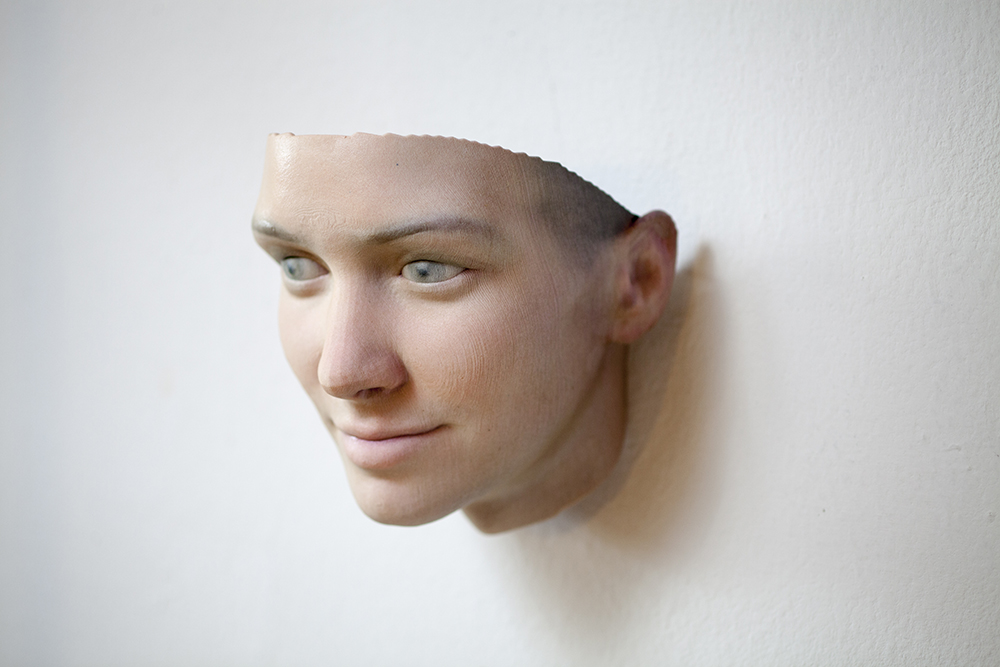
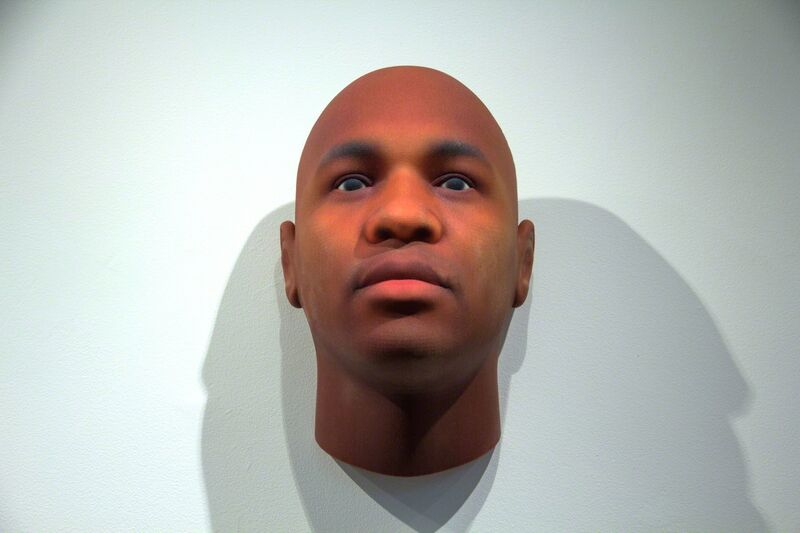
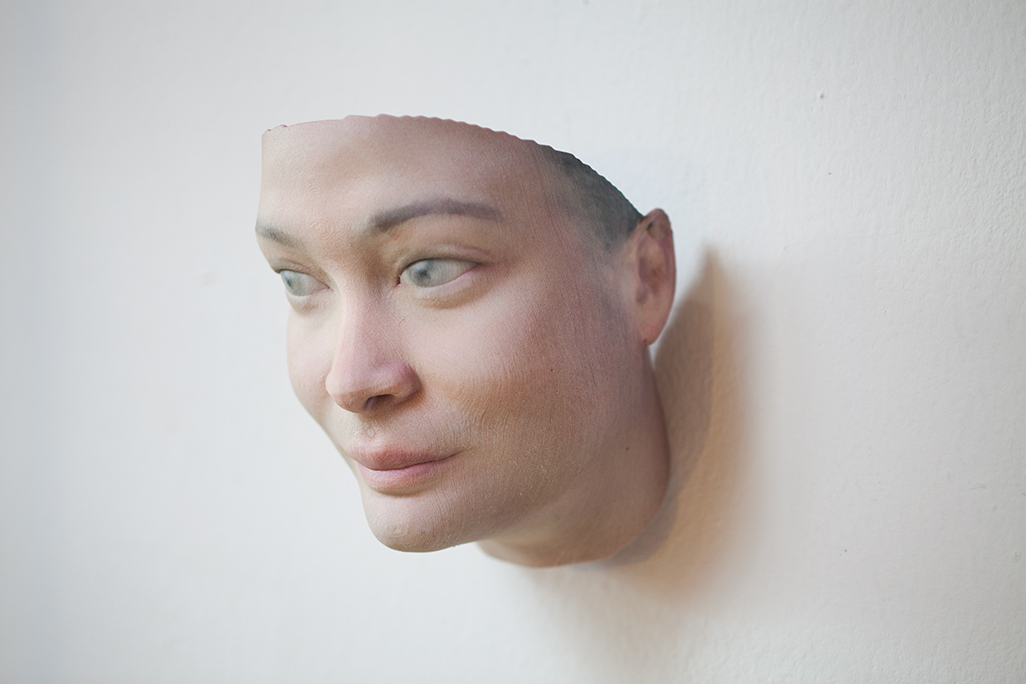
________________
Alberto Frigo Images of the artifacts used by the main right hand (2015)
‘Italian Alberto Frigo’s series ‘Images of the artifacts used by the main right hand’ comprehensively documents the thousands of everyday objects he has used for more than a decade. Photos included in the Lifelogging exhibition show hairbrushes, toothbrushes, drinks, food, reading glasses and more. The 35-year-old Sweden-based artist used a small digital camera to record all objects he came into contact with in what he calls a ‘DNA code for other humans to interpret’.’


________________
Lawrence Abu Hamdan Contra Diction: Speech Against Itself (2016)
‘What is the interrelationship between the human voice, governmental law and the concept of justice in the technosphere? In a live audio essay, a series of sonic manipulations and pre-recorded samples are employed to explore the concept and practice of taqiyya—the right to lie or a piece of Islamic jurisprudence that allows a believing individual to deny their faith or commit otherwise illegal acts while they are at risk of persecution or in a condition of statelessness. It is a form of communication and political practice forged at remote altitudes, at the fringes of failed states, in buffer zones and on ceasefire lines. Focusing on the stories of alleged mass conversions of the Druze minority in northern Syria by wahhabi groups, Abu Hamdan investigates how such minor speech acts can help re-appraising the precision of speaking, the multiple ways of remaining silent and the inherently unfaithful nature of one’s voice.’
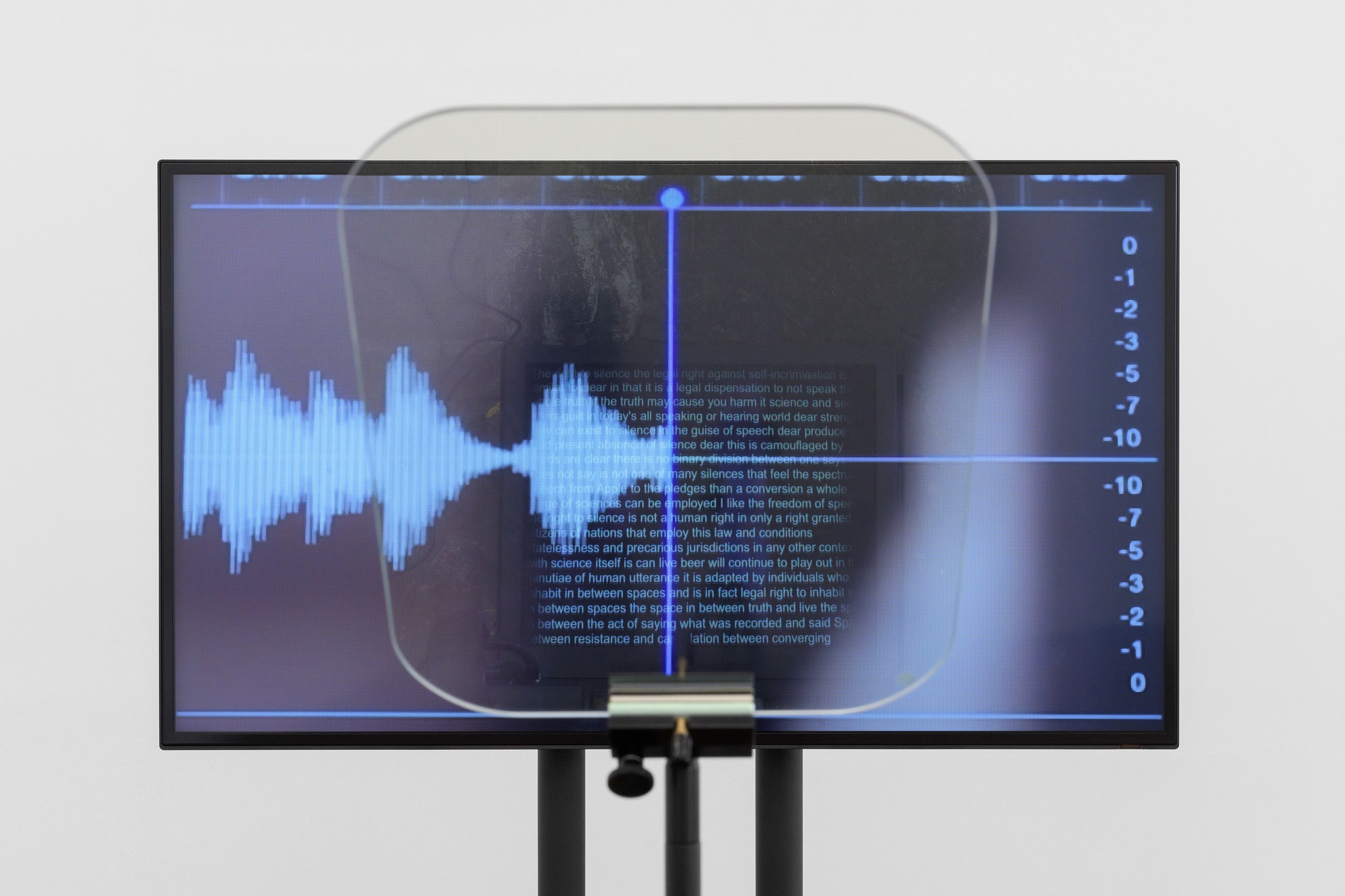
________________
Melanie Lowe You Saw Me? (2008)
‘Facebook allows users to relate to each other through the posting of notes, photographs and status updates for the possibility of connection. As a relational apparatus, Facebook allows for the possibility of simultaneous intimacy and distance. This project takes the Facebook status update of participants from its original context and places it in a representative role of Facebook culture, language and syntax where one’s status serves as affirmation and disclosure. It is the desire for acknowledgment through communication to one’s friends and functions as a fleeting representation of the self in a moment of time.’
________________
Eva & Franco Mattes Dark Content (2015)
‘A series of video installations about internet content moderators. Contrary to popular belief, the removal of offensive material from the Internet is not carried out by sophisticated algorithms. It is the nerve-wracking, demanding job of thousands of anonymous human beings: people disguised as algorithms. We have interviewed one hundred moderators, and created videos in which avatars with computer-generated voices speak in their place, recounting memories about content they removed from the web, including pornography, sexual solicitation, racism.’
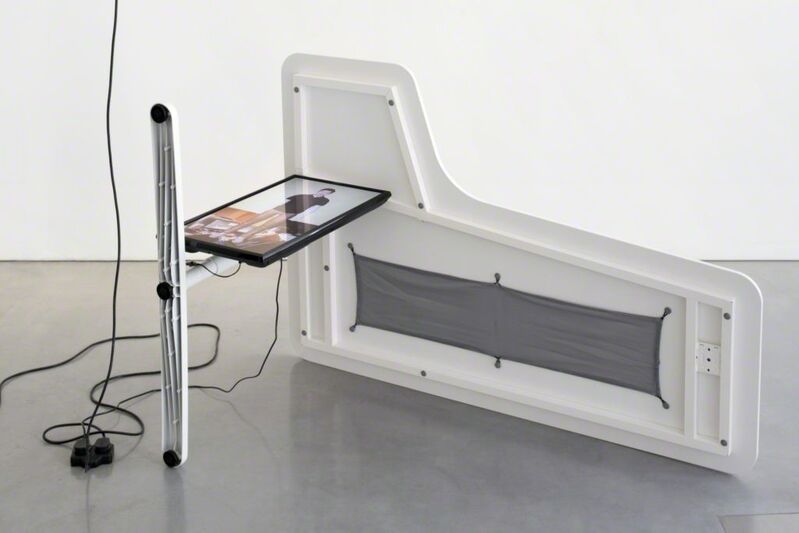
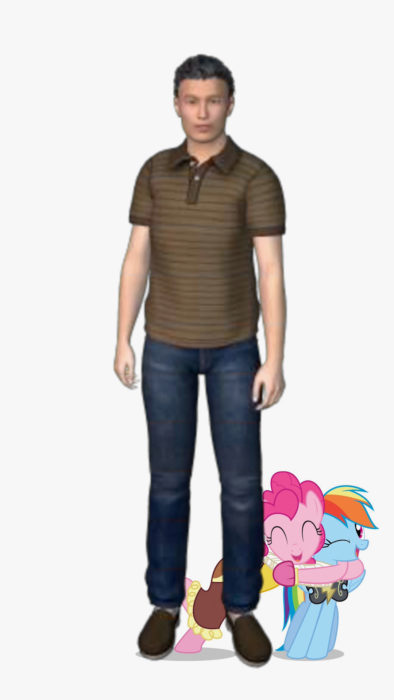
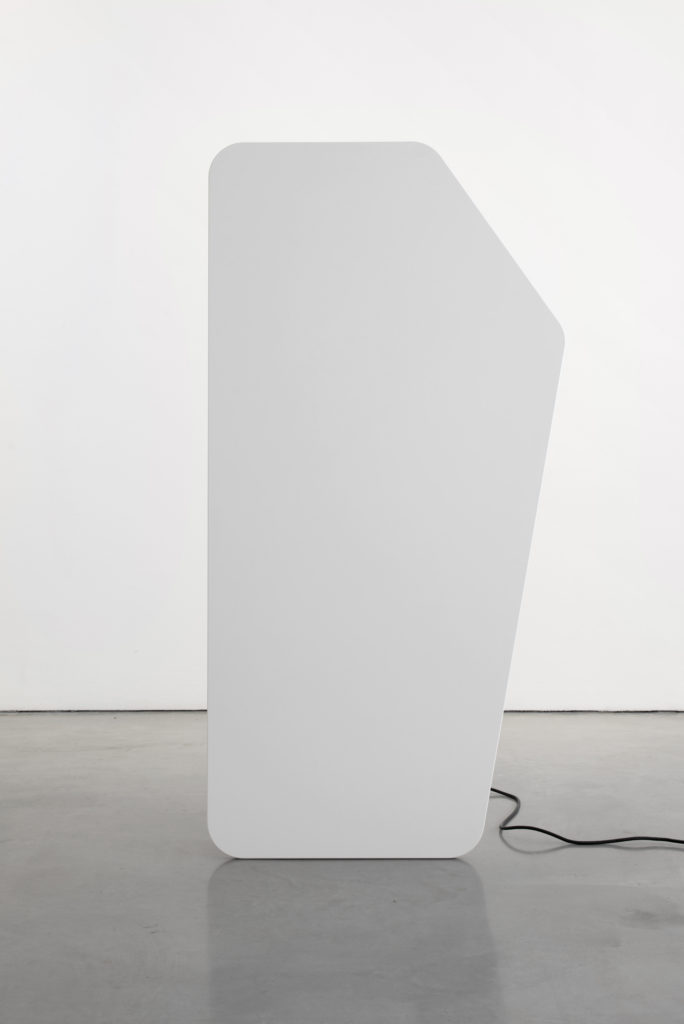
_______________
Ann-Sofi Sidén Sticky Floors (Lunch to Last Call) (2014)
‘Sticky Floors shows nondescript 24 hours of a pub in Ireland. Through nine surveillance cameras, the owner of the pub and its customers are observed. In presenting moments in lives of diverse types of people and almost boring scenes from monotonous daily routines, the artist shows them in a manner of ‘carving the time’ as if she prunes a tree and trim its branches. She does so by composing images and editing the source video, rather than using the original video as it is. Installed with objects that include beer glasses, nine monitors, and trays used in a pub, the work invites its viewers to ‘observe’ the lives of those that appear in the video from certain distance and eye-level for watching a video installation.’

________________
Julia Scher Recovery Agent (1987)
‘First performed in 1987 at Medium West, Minneapolis. Performance with security and surveillance equipment. One of the first installative presences animating the world of security sales with a mad-cap, jungle-like structure.’
________________
!Mediengruppe Bitni Surveillance Chess (2012)
‘I’ve hijacked your surveillance camera. How about a game of chess?” The words filled a closed-circuit television screen that only seconds before had shown commuters in London’s Charing Cross station. Whichever security guard read the message soon saw it replaced by a chessboard and the words: “You are white. I am black. Call me or text me to make your move. This is my phone number: 075 8246 0851.” In the heart of the world’s most surveilled city, two artists were registering their polite protest with the help of a laptop and an interfering transmitter. Carmen Weisskopf and Domagoj Smoljo, a Swiss team known as !Mediengruppe Bitnik, have been co-opting the spy’s arsenal to practice their own, artistic style of counter-espionage.’

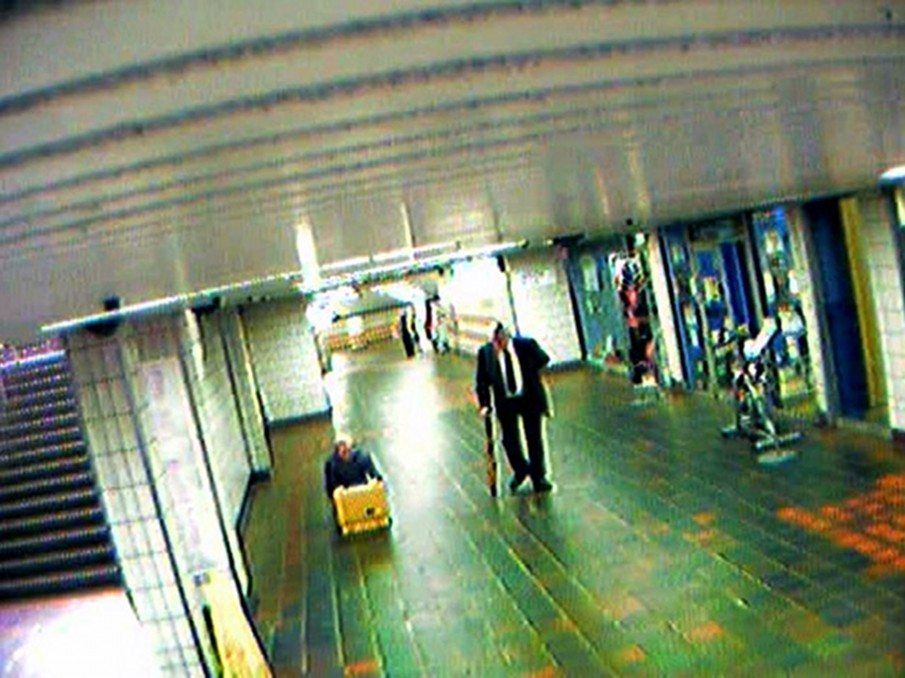
______________
Marcha Schagen and Leon Baauw KOVR (2016)
‘The idea of wearing an anti-surveillance jacket might sound a bit paranoid — until you remember that the NSA has full access to your dick pics. And in the apocalyptic event of a Trump-ruled police state, such designs could prove crucial for the future of free expression. “We believe that this kind of fashion is already commonplace,” the designers said. “We wear clothes to protect us from the cold, firefighters and race car drivers wear heat protective outfits and soldiers have bulletproof uniforms. Clothing has always been there to protect us — this is doing the same, just from a modern day threat.”’
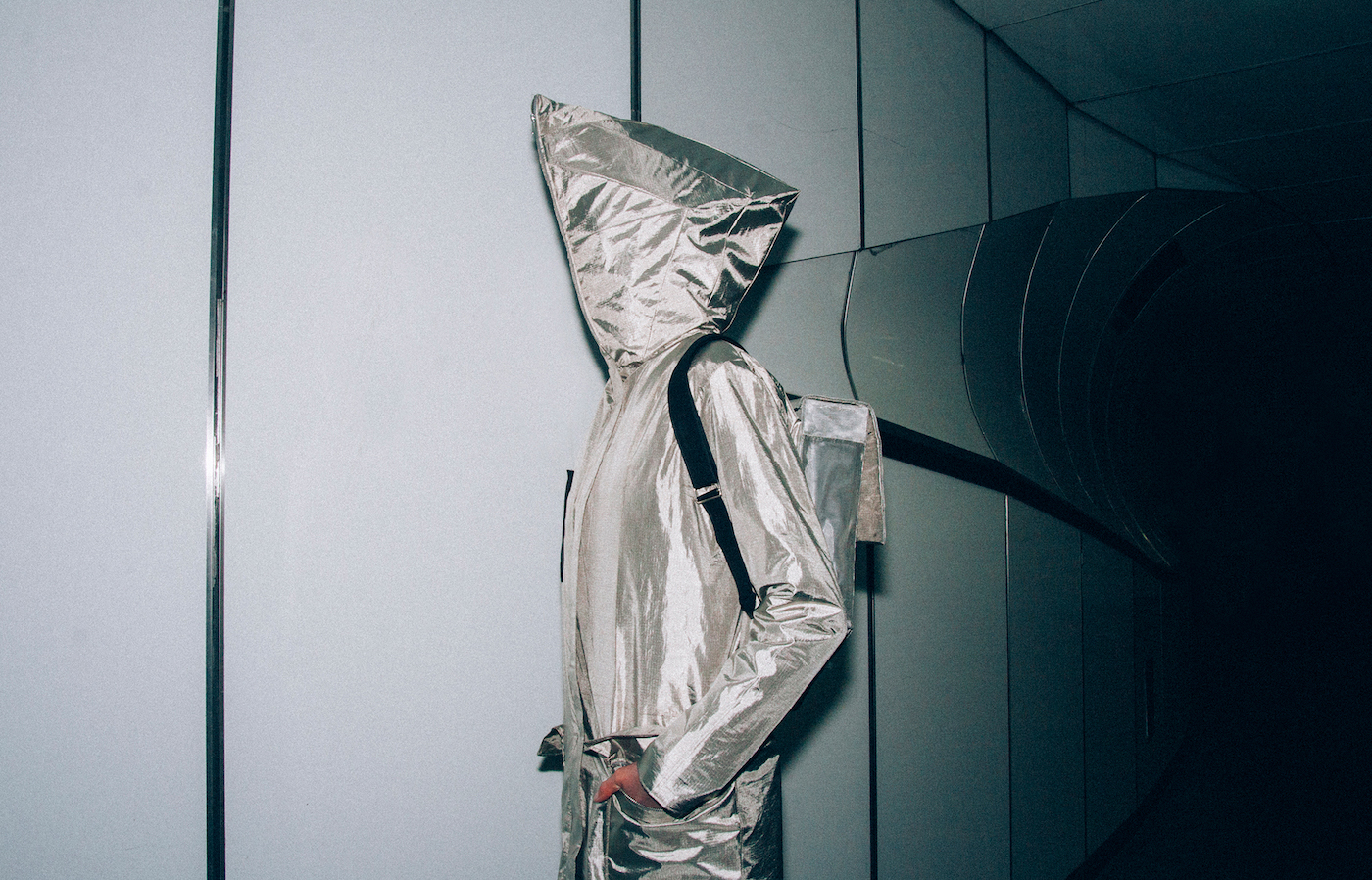
______________
Seiko Mikami Desire of Codes (2011)
‘A large number of devices resembling tentacles with built-in small cameras are placed across a huge wall, while six robotic “search arms” equipped with cameras and projectors are suspended from the ceiling. Each device senses with insect-like wriggling movements the positions and movements of visitors, and turns toward detected persons in order to observe their actions. In addition, a giant round-shaped screen that looks like an insect’s compound eye is installed in the back of the exhibition space. Visual data transmitted from each camera, along with footage recorded by surveillance cameras installed at various places around the world, are stored in a central database, and ultimately projected in complex images mixing elements of past and present, the venue itself and points around the globe, onto the screen. The compound eye visualizes a new reality in which fragmentary aspects of space and time are recombined, while the visitor’s position as a subject of expression and surveillance at once indicates the new appearances of human corporeality and desire.’
_____________
Leoplod Kessler Flying Police Capsule (2011)
‘Flying Police Capsule documents Kessler’s intervention in Singapore where one pod of the largest Ferris wheel in the world is marked with the word POLICE. The political and social implications of the sign seem credible at first, yet the slowness of the turning wheel presents an absurdity as the rotating capsule is converted into a mechanism of transgression.’


________________
Ben Grosser ScareMail (2013)
‘ScareMail is a web browser extension that makes email “scary” in order to disrupt NSA surveillance. Extending Google’s Gmail, the work adds to every new email’s signature an algorithmically generated narrative containing a collection of probable NSA search terms. This “story” acts as a trap for NSA programs like PRISM and XKeyscore, forcing them to look at nonsense. Each email’s story is unique in an attempt to avoid automated filtering by NSA search systems.’
________________
Trevor Paglen They Watch the Moon (2010)
‘They Watch the Moon depicts a secret NSA listening station deep in the forests of West Virginia. The station is at the centre of the National Radio Quiet Zone, a region of approximately 34,000 square kilometres in West Virginia and parts of Maryland. Within the Quiet Zone, WiFi, FM radio and similar transmissions are not permitted so that astronomers can use sensitive radio telescopes to observe distant galaxies. The listening station, which forms part of the global ECHELON system, was designed in part to take advantage of a phenomenon called ‘moonbounce’ (capturing communications and telemetry signals from around the world as they escape into space, hit the moon, and are reflected back towards Earth). The photograph is a long exposure under the full moon.’

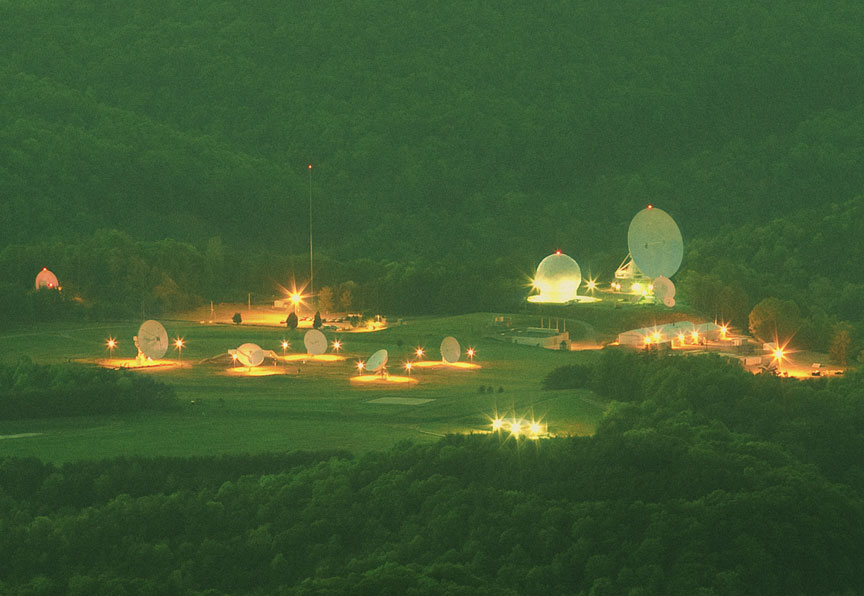
_________________
Sang Mun ZXX (2012)
‘Over the course of a year, I researched and created ZXX, a disruptive typeface which takes its name from the Library of Congress’ listing of three-letter codes denoting which language a book is written in. Code “ZXX” is used when there is: “No linguistic content; Not applicable.” The project started with a genuine question: How can we conceal our fundamental thoughts from artificial intelligences and those who deploy them? I decided to create a typeface that would be unreadable by text scanning software (whether used by a government agency or a lone hacker) — misdirecting information or sometimes not giving any at all. It can be applied to huge amounts of data, or to personal correspondence. I drew six different cuts (Sans, Bold, Camo, False, Noise and Xed) to generate endless permutations, each font designed to thwart machine intelligences in a different way. I offered the typeface as a free download in hopes that as many people as possible would use it.’
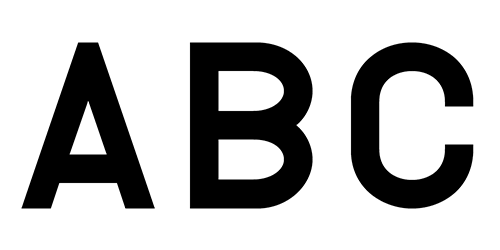
_______________
Marnix de Nijs Physiognomic Scrutinizer (2009)
‘The design of the Physiognomic Scrutinizer is based on principles employed in security gates seen at airports, shopping malls, football stadiums and other protected public spaces. A barrier guides visitors towards a brightly lit entrance, where a mounted camera records each individual’s image and projects it on an LCD monitor at the back of the gate. A speaker on a stand, positioned immediately behind the gate, symbolizes and acts as a security guard. The installation scans facial features and characteristics by using biometric video analysis software, and compares them to those of more than 250 preselected people in a database. The database includes a variety of famous individuals and contributors to our contemporary culture, all chosen because of their controversial or infamous acts. A computerized voice publicly announces the name of the person each viewer has been identified as, in a confrontational reminder that the steady increase in the use of biometric technology in public space should be viewed with a healthy skepticism.’
_______________
Lee Friedlander New York City (1966)
Gelatin silver print

_______________
Vito Acconci Following Piece (1969)
‘In the fall of 1969, Acconci randomly selected and then followed individual passersby he encountered in New York City, maintaining his pursuit until the person entered a building. The process varied in length from a few minutes to several hours and took the artist around Manhattan and into Brooklyn, Queens, and the Bronx, as shown in the work’s central map. Though this stalking was aggressive, by allowing a stranger to determine his route the artist gave up a certain degree of agency. He said, “I am almost not an ‘I’ anymore; I put myself in the service of this scheme.” A typescript lays out the terms of the “scheme,” and this photocollage documents several of the actions.’


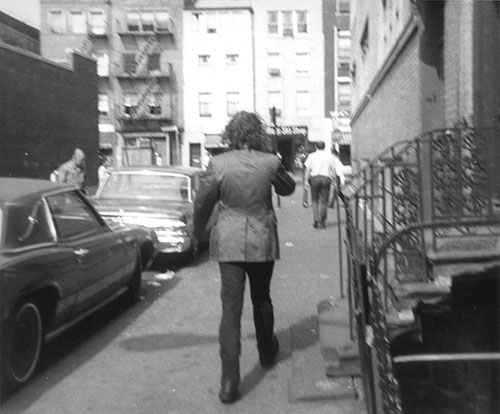
_______________
Harun Farocki Eye/Machine I (2003)
‘In the video installation Eye/Machine I (2000), Farocki deals with the possibilities of intelligent image processing. He focusses on identity-finding and monitoring procedures that were originally developed for military purposes and now contribute to the fact that machines can operate in civil areas without the assistance of humans. To illustrate this connection between the disappearance of manual labour and the abolition of eye labour, Farocki uses recordings from research institutions, film archives, and advertisement departments; he interrelates and compares them in many different ways.’
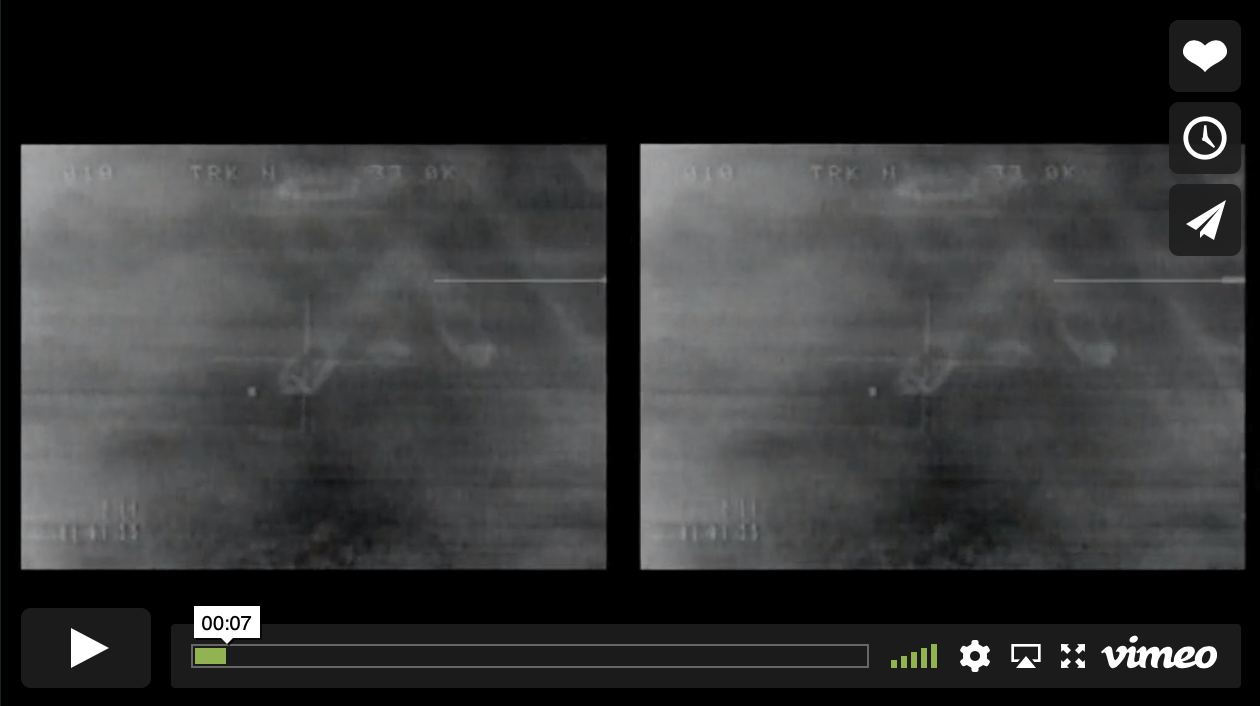
___________________
Elia Gasparolo and Joaquín Fargas Robotika The Nannybot (2019)
‘Argentinian media artists Elia Gasparolo and Joaquín Fargas’ Robotika: The Nannybot is a cyber nanny that uses facial recognition to learn how to take care of a human baby, which would ‘assist in the preservation of the human species’ as a kind of ‘Galactic Ark’ if ‘the end of human civilization arrives in a near or distant future’.’

__________________
Paolo Cirio and Alessandro Ludovico Face-to-Facebook (2011)
‘In 2008 when Cirio and Ludovico began developing the Face-to-Facebook, facial recognition using artificial intelligence was only just starting to become commercially available for non-expert users. Therefore, as Cirio once explained to me, they bought a facial recognition algorithm ‘from an Italian coder who had one of the few available worldwide’. Customizing this software in the MATLAB computing environment and programming language developed by MathWorks, Cirio and Ludovico ‘selected forty samples for each category in an “arbitrary” way based on how they appeared’ in order to train their neural network. The facial recognition then proceeded to successfully classify 250,000 profile pictures from their web-scrapped dataset. After sharing these images on a dating website, ‘www.Lovely-Faces.com’, the media artists received ‘worldwide press coverage of more than one-thousand media outlets from all over the world in just a few days’ as well as three cease and desist letters from Facebook. By taking a ‘critical action against a giant online corporation’ that ‘shows how fragile and potentially manipulatable the online environment actually is’, Cirio and Ludovico positively changed the public conversation about privacy settings on social media. In fact, after Face-to-Facebook, Facebook proceeded to completely overhaul their privacy settings.’
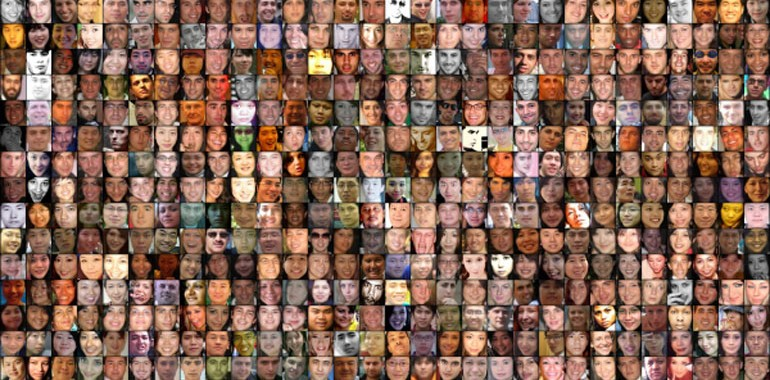

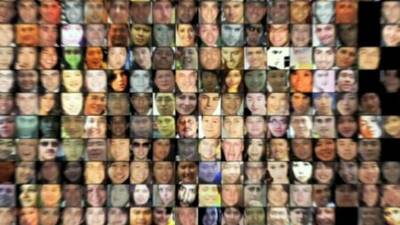
________________
David Bowen Fly Tweet (2012)
‘Fly Tweet that enables a swarm of common houseflies to speak via Twitter. The flies live inside an acrylic sphere containing a standard computer keyboard and as they interact inside their home their movements are collected and analyzed in real-time via video. As a particular key is triggered by the aggregated movement the corresponding character is inputted into a Twitter text box. If the flies trigger the return key the latest message containing the accumulated characters is tweeted or if a full 140 characters are reached before the enter key is activated a message is automatically sent out to all 82 (as of April 17) of the swarm’s followers.’
________________
Tomas van Houtryve Blue Sky Days (2012)
‘In October 2012, a drone strike in northeast Pakistan killed a 67-year-old woman picking okra outside her house. At a briefing held in 2013 in Washington, DC, the woman’s 13-year-old grandson, Zubair Rehman, spoke to a group of five lawmakers. “I no longer love blue skies,” said Rehman, who was injured by shrapnel in the attack. “In fact, I now prefer gray skies. The drones do not fly when the skies are gray.” With my camera attached to a small drone, I travelled across America to photograph the very sorts of gatherings that have become habitual targets for foreign air strikes—weddings, funerals, groups of people praying or exercising. I also flew my camera over settings in which drones are used to less lethal effect, such as prisons, oil fields, and the U.S.-Mexico border. The images captured from the drone’s perspective engage with the changing nature of surveillance, personal privacy, and war.’
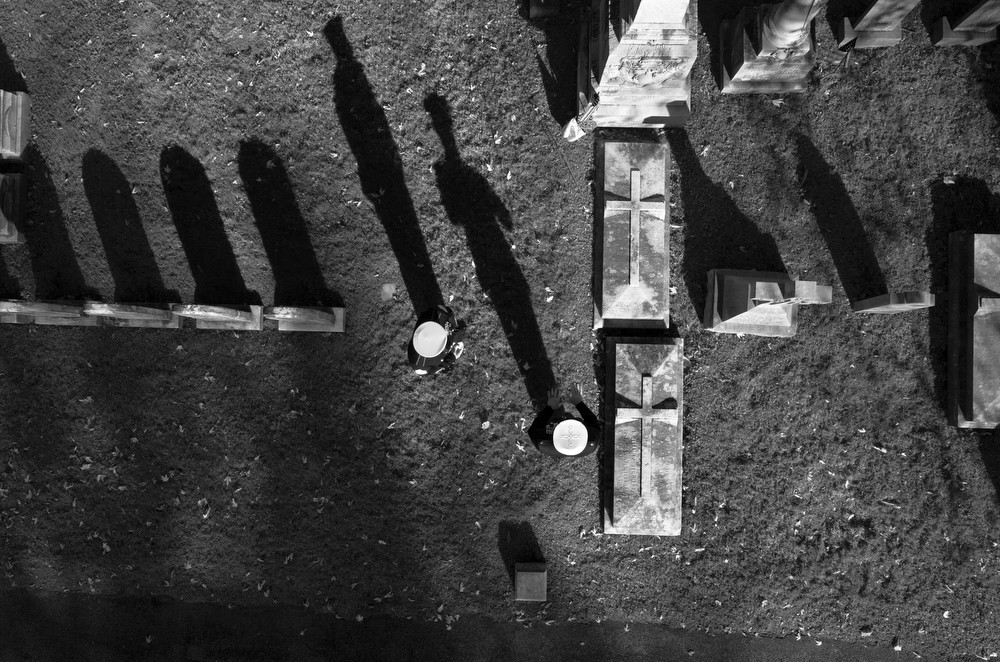
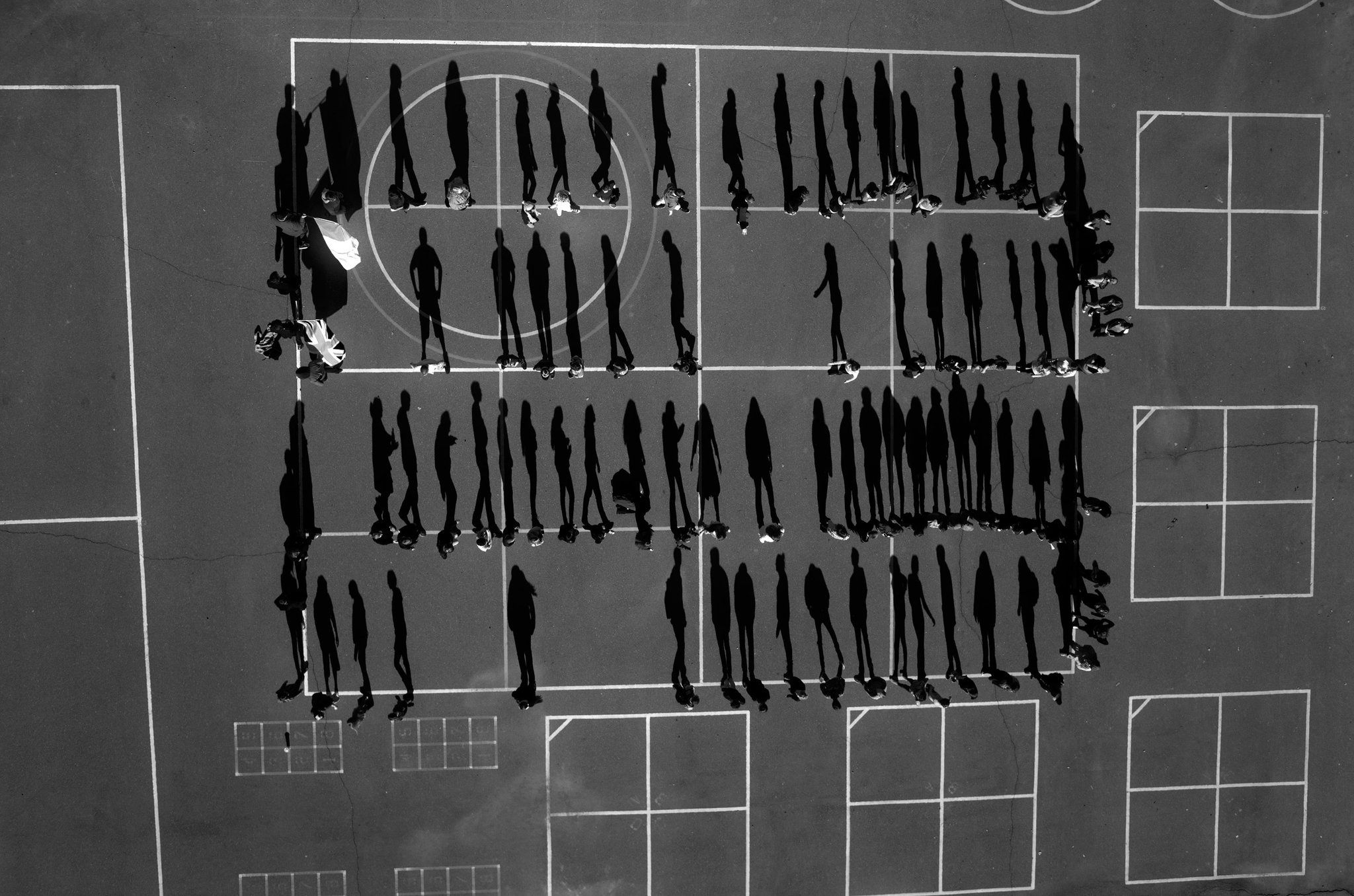
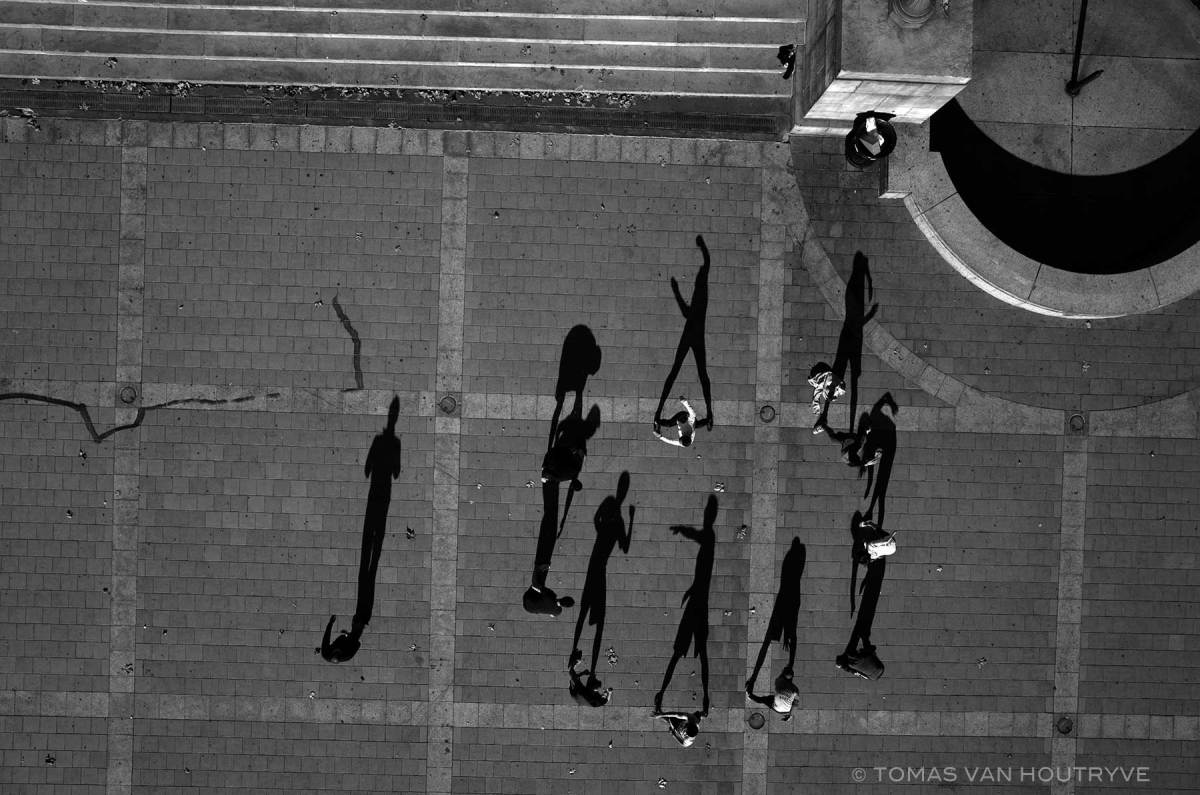
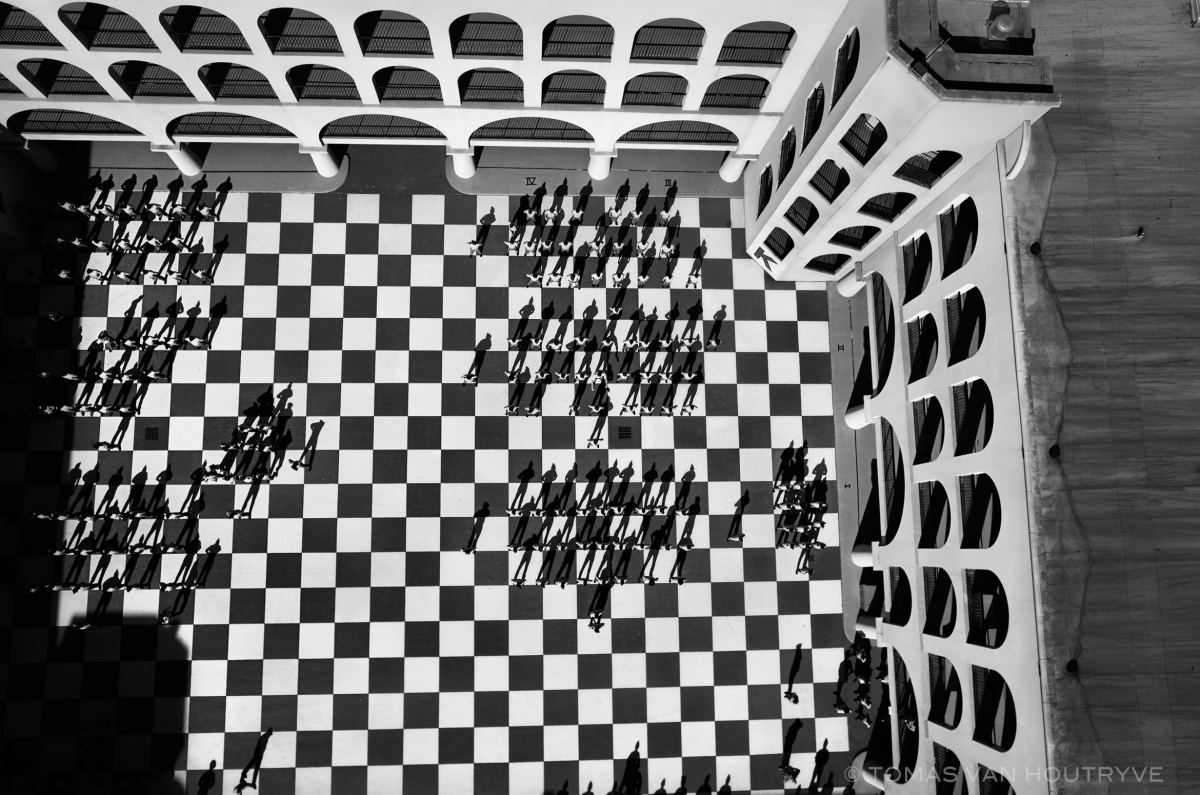
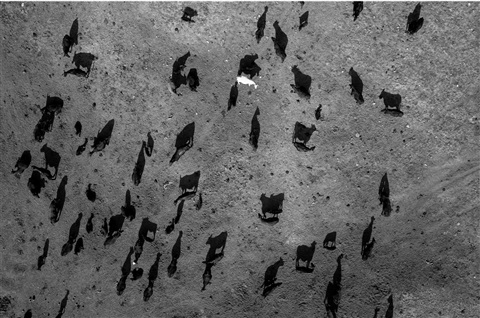
________________
Aron Ranen Television Believers (1986)
‘Aron Ranen collaborates with the “Amazing Randy” to expose Peter Popoff. This TV Preacher had a receiver hidden inside his ear, which his wife used to communicate names & illness of people in the crowd, giving the illusion of “Psychic Powers”. At the time of the making of this film, he was making $500,000 a month…Tax Free.’
________________
Julius von Bismarck, Benjamin Maus and Richard Wilhelmer Public Face (2007)
‘The project Public Face I (Stimmungsgasometer) by Julius von Bismarck, Benjamin Maus & Richard Wilhelmer is about a smiley on a huge screen from which one can read the average mood of the Berlin citizens. The system allows to read emotions out of random peoples faces. The faces are analyzed by sophisticated software (contributed by the Fraunhofer Institut). The obtained mood data are then stored on a server and processed by the smiley on the screen to visualize the emotions in real-time.’

_______________
Sophie Calle The Hotel (1981)
‘On Monday, February 16, 1981, I was hired as a temporary chambermaid for three weeks in a Venetian hotel. I was assigned twelve bedrooms on the fourth floor. In the course of my cleaning duties, I examined the personal belongings of the hotel guests and observed through details lives which remained unknown to me. On Friday, March 6, the job came to an end.’ — SC

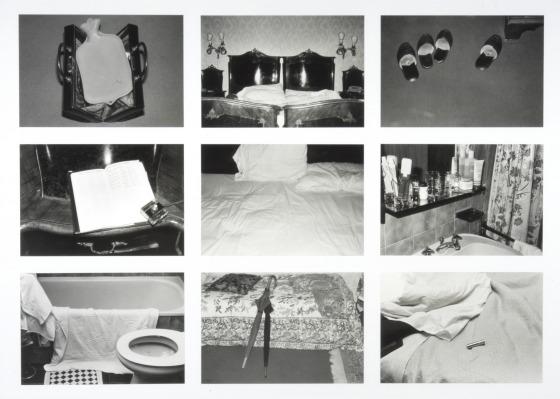
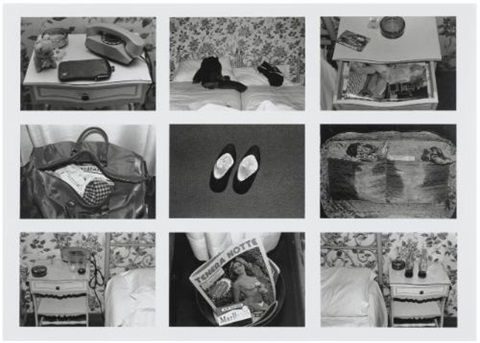
_______________
Noelle Mason I Like America and America Likes Me (2018)
‘Mason’s filmic comment on the perceptual effect of thermal, digital and sonic imaging techniques. A camera tracks a row of migrants through the dark landscape at the US border, their blurry silhouettes intercut with coyote hunts. Mason expresses the latent violence of these mediating technologies as the crosshairs of a rifle from this latter footage rest on their prey.’
_______________
Rafael Lozano-Hemmer Level of Confidence (2015)
‘Level of Confidence is an art project to commemorate the mass kidnapping of 43 students from the Ayotzinapa Rural Teachers’ College in Iguala, Guerrero, Mexico. It was released on March 26, 2015, exactly six months after the kidnapping took place. The project consists of a face-recognition camera that has been trained to tirelessly look for the faces of the disappeared students. As you stand in front of the camera, the system uses algorithms to find which student’s facial features look most like yours and gives a “level of confidence” on how accurate the match is, in percent. The biometric surveillance algorithms used – Eigen, Fisher and LBPH – are typically used by military and police forces to look for suspicious individuals whereas in this project they are used to search for victims instead. The piece will always fail to make a positive match, as we know that the students were likely murdered and burnt in a massacre where government, police forces and drug cartels were involved, but the commemorative side of the project is the relentless search for the students and the overlap of their image with the public’s own facial features.’

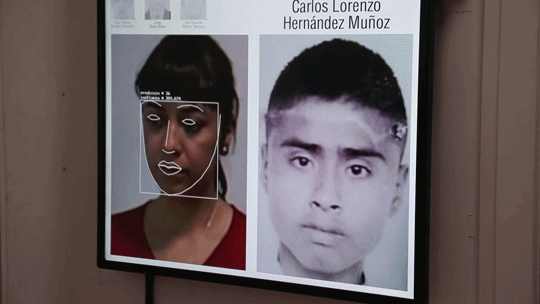
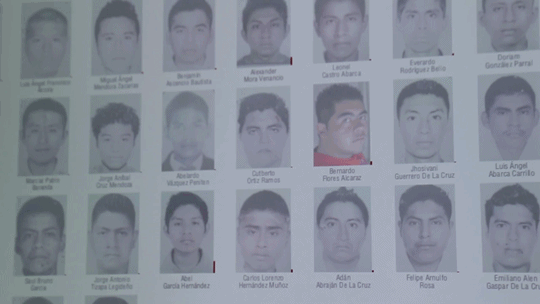
*
p.s. Hey. ** Dominik, Hi!!! Zac was supposed to order the buche yesterday, and hopefully he did. I did start watching the Soft White Underbelly videos, and, yeah, fascinating. I don’t think I watched the two you mentioned yet, but they’re next. Thank you a lot for the turn on. Dancing like a worm is the quickest way to my … heart, how did you know? Love has the hiccups, G. ** David Ehrenstein, I am in agreement! ** David, It could be argued that all butterflies are nice. It could also be argued that niceness is a quality that humans impose upon butterflies who are just trying to live their lives the only way they know how. I assume Gahan floated your boat, battleship even? Did he do ‘Just Can’t Get Enough’? Ha ha. A fine, fine weekend to you too, sir. ** Tosh Berman, I haven’t seen the Mishima starring film, and I didn’t know the two had crossed paths until I made the post. Curious. I guess, according to Steve and Brian, it’s a mini-retrospective, but hey. Have a blast of a weekend. ** _Black_Acrylic, ‘Blind Beast’ is a lot of fun, and, yes, probably not destined to be in your parents’ top ten all-time favorite films you made them watch. ** Steve Erickson, Ah! Everyone, The NYC Masumura retrospective I mentioned yesterday is, in fact, rather a little Masumura survey thing featuring a handful of his films, but, the point is, thanks to the industriousness of Mr. Erickson and Brian, I can hereby inform you that you can still attend the fest if you hurry, starting with the basic info here. Year end lists. I’m doing my usual one for the blog almost as I type. It doesn’t … seem like there’s going to be some big, sudden shift in the Covid stuff in the immediate future, at least where you are — I think we’re about to get a lockdown for the unvaccinated here in France — so hopefully you and your parents will be joyously united. ** Brian, Hi, Brian! I’m glad the films made you happy. Yeah, that set, right? You’re outta there today, eh? I hope the traveling is a scoot. My weekend? I’m doing a Zoom conversation on Monday with the great artist Ryan Trecartin for Artforum/Bookforum — they’re doing a writers and artists in conversation series — so I’ll be catching up with his videos that I haven’t yet seen. Tomorrow is the press/cast/crew screening of the film of Gisele Vienne’s and my ‘Jerk’, so I’ll be there watching and doing the Q&A and all of that. Today/tonight there’s a conference on Gisele’s work here, and I might go to that. And whatever else pops up. How and what was your first post-NYC weekend like, man? Big up! ** Okay. Up above is a big pile of things for you to scroll through, read, click, meditate upon, and hopefully not get too paranoid about. See you on Monday.




 Now available in North America
Now available in North America 
Thanks for this post… when I was a boy 11 or 12ish? something like that…. a new chemist opened and this news reader Bob Warman was opening it…. he was known for being on tv with a dog called ‘newshound’… I stood in line with a voucher taken from the local newspaper… I got to meet him and was given a free gift!!…. I was very disappointed that the dog wasn’t there though… on getting home my grandmother rolled up and said she also had a voucher could I go back and her a free gift?… so I said ‘ok’ on getting there Bob had long gone… and there was just some sour faced cow…. on seeing me she said “oi get out!!! get out!!!! you were here earlier messing around spraying all the perfumes running a mock!!!!” it was a case of mistaken identity for certain…. no cctv back then….
Here is a section from a poem I wrote many years later about ‘the Mare of Liverpool’…. (the other mare) referencing CCTV…. and one of my visits…. “….devil’s divinity, I enter the sacrosanct vicinity, Caught on camaraderie, Being here means a fucking lot to me! Antichrist halo, god on my shirt, Settling nicely into the framework…”
I bought a bottle of Paul Smith’s Rose that time and wasn’t accused of running a mock…
Dave Gahan sang ‘John the Revelator…’. ‘Smile’ though your heart is breaking’ and ‘Always on my mind’…. the rest were unknown great songs from his new album… it was a seated event…. I was in row 2 with a clear view at the middle/side… It was like a concentration camp on liberation day at the end Den…. there had been loads of Germans calling out between songs such things as ‘you are wearing too many clothes for my liking!!!” … dry ice added to the effect… another kept randomly running over and poking this woman from Coventry in front of me all through the show… saying ‘you speak a very much no??? for the last song ‘john the revelator’ there was a bit of a scrum and a dive to get close to the stage…. a nazi pushed at my with his arm…. and my warewolf teeths started to grow…. odd to be that close… literally it was just the nazi infront of me and then it was Dave… I had a piss in the urinal before leaving and then posed for a picture with a statue of christ in the reception….
ok… better go and do my run…. adieu Dennis xx
That poem sounds like it’s a real belter, come ‘ed! where’s the rest of it? I’d love to hear it! I’ve always loved Paul Mccartney
Thanks… Aveline of Liverpool?
Hi!!
You’re very welcome, of course! I’m really glad I could show you something new and intriguing with the SWU videos!
Okay. Yes. Your love definitely made my weekend a pretty nice one. Thank you! Love lip syncing RuPaul songs on the train because he feels safe and confident behind his mask, Od.
Latest FaBlog: The Talented Mr. Crumbley
Crumbley’s in custardy
And so are his parental units/ co-killers
Just Desserts? cheers Dave x
That Trecartin interview sounds exciting. When will Artforum post it?
I forgot to write this earlier – have you heard of the music sub-genre sibilkore? It’s a mix of trap music and hyperpop, usually with references to Satanism. I’m not sure what I think, but Luci4’s “Kurxxed Emeraldz” video, with a dancing animated devil, is quite charming,
Hey Dennis. Wow, this is a dense post… A lot to chew on The only thing I can say right now is that, should mass surveillance cause us to go out wearing the ‘Fag Face’ mask, or the KOVR jacket, or even append surreal machine-generated short stories to every email we send, then even if it is a massive, murderous bitch, every cloud has a silver lining right? I’m definitely gonna come back to watch the rest of the Erewhon video series in particular, but there was a lot that wriggled its way inside my brain. Hope the new week does similarly, pleasurably to you, even? xT
Definitely paranoia-inducing, and how apt that you’ve got a Google reference worked in at the top there. I do still use that search engine, probably through force of habit, but then I’m doubtless complicit in myriad everyday forms of tech surveillance, sigh.
somehow the link on your website to this blog is not working.
it only works if the https is in the beginning. i was convinced the blog was down the last 4 month.
anyways im happy to be back and catch up on some reading.
xxx
Big D! We’re already in the surveillance state and they’re jacking it up by the second. It’s just not evenly distributed just yet. I fucking hate it.
Thanks about my mom. He spunk is a little different from others’, hahaha. 😉
We went to an Italian restaurant and had a good meal and then came home for cake and ice cream and watching football.
Hahaha, I just told David the other day that he’s the “Tiger King.” Great minds, eh?
Man, the shit he gets up to.
We’ve got to call about his car tomorrow. Got it towed to a shop yesterday.
I’ve been so fucking busy at work and stressed at home. Erp. I need to go look at the Buche day. Was gonna ask you about it a couple weeks ago, forgot, and then totally missed it this week. Well, I saw it on FB but didn’t have a chance to give it a good look.
Onward and upward.
Hey, Dennis,
Amazing works all, but the eloquence of the Friedlander is just so perfect. Also love the Fag Face mask and Desire of Codes. But they’re all great. Talking to artists, screening a film, conferences on collaborators: your weekend sounds very full, pleasantly so, I hope. Looking forward both to your Artforum conversation and to the taped “Jerk”, whenever either of those materialize on this side of the Atlantic. My first weekend home was exhausting. Really early start moving out on Saturday, and then that very evening two relatives visiting from Ireland, staying over for the weekend. It’s wonderful to see them after so long a period of separation, naturally; I’m just tired, but I’ll get to unwind a little more tomorrow. So pretty good, all things considered. Working myself up for the finals to come. That’s all, nothing exceptional. All the best for the week ahead.
Hey Dennis, I’m feeling good about this day based on my current body of work. And speaking of, I dropped off a Safer at Home book for you yesterday at the house. Hope you can make it over here soon! Love, B